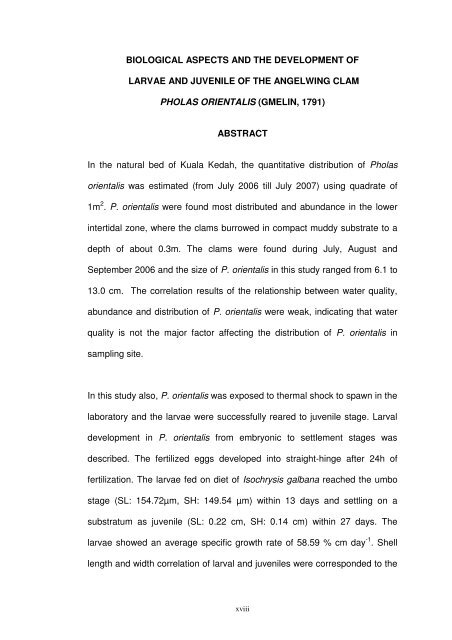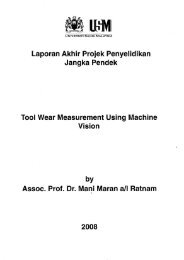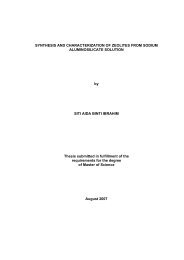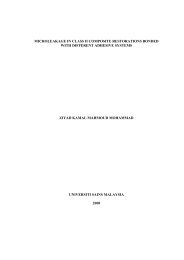biological aspects and the development of larvae ... - ePrints@USM
biological aspects and the development of larvae ... - ePrints@USM
biological aspects and the development of larvae ... - ePrints@USM
Create successful ePaper yourself
Turn your PDF publications into a flip-book with our unique Google optimized e-Paper software.
BIOLOGICAL ASPECTS AND THE DEVELOPMENT OF<br />
LARVAE AND JUVENILE OF THE ANGELWING CLAM<br />
PHOLAS ORIENTALIS (GMELIN, 1791)<br />
ABSTRACT<br />
In <strong>the</strong> natural bed <strong>of</strong> Kuala Kedah, <strong>the</strong> quantitative distribution <strong>of</strong> Pholas<br />
orientalis was estimated (from July 2006 till July 2007) using quadrate <strong>of</strong><br />
1m 2 . P. orientalis were found most distributed <strong>and</strong> abundance in <strong>the</strong> lower<br />
intertidal zone, where <strong>the</strong> clams burrowed in compact muddy substrate to a<br />
depth <strong>of</strong> about 0.3m. The clams were found during July, August <strong>and</strong><br />
September 2006 <strong>and</strong> <strong>the</strong> size <strong>of</strong> P. orientalis in this study ranged from 6.1 to<br />
13.0 cm. The correlation results <strong>of</strong> <strong>the</strong> relationship between water quality,<br />
abundance <strong>and</strong> distribution <strong>of</strong> P. orientalis were weak, indicating that water<br />
quality is not <strong>the</strong> major factor affecting <strong>the</strong> distribution <strong>of</strong> P. orientalis in<br />
sampling site.<br />
In this study also, P. orientalis was exposed to <strong>the</strong>rmal shock to spawn in <strong>the</strong><br />
laboratory <strong>and</strong> <strong>the</strong> <strong>larvae</strong> were successfully reared to juvenile stage. Larval<br />
<strong>development</strong> in P. orientalis from embryonic to settlement stages was<br />
described. The fertilized eggs developed into straight-hinge after 24h <strong>of</strong><br />
fertilization. The <strong>larvae</strong> fed on diet <strong>of</strong> Isochrysis galbana reached <strong>the</strong> umbo<br />
stage (SL: 154.72µm, SH: 149.54 µm) within 13 days <strong>and</strong> settling on a<br />
substratum as juvenile (SL: 0.22 cm, SH: 0.14 cm) within 27 days. The<br />
<strong>larvae</strong> showed an average specific growth rate <strong>of</strong> 58.59 % cm day -1 . Shell<br />
length <strong>and</strong> width correlation <strong>of</strong> larval <strong>and</strong> juveniles were corresponded to <strong>the</strong><br />
xviii
















